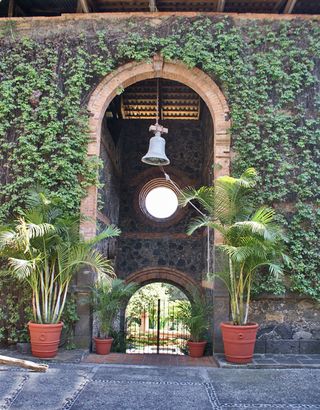
Fábrica San Pedro, a textile factory
built in Uruapan in the late 19th century, still operates along the banks of the Río Cupatitzio, just a few blocks from the Uruapan's downtown Plaza Morelos. One of the largest water-powered mills in the region, this
factory produced as many as 40,000 blankets during its heyday.
American expatriates Walter and Bundy Illsley, residents of Mexico since 1954, bought the
mill in the late 1980s. Their company, Telares Uruapan, still
produces hand-loomed natural fibers in traditional local colors and designs, as well as in the
custom designs that the Fábrica exports all over the world. Walter Illsley died in late March 2009, but his wife and their son, Rewi, continue to carry on the traditions of the Fábrica.
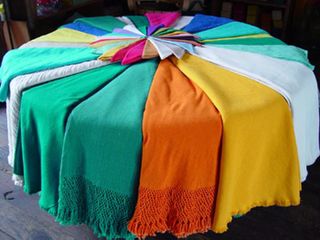
Hand-woven tableclothes are made and sold at the Fábrica San Pedro in Uruapan.
The Illsleys' restoration of the Fábrica San Pedro is a joy to behold. From the entrance to the back reaches of the buildings, enormous care has been taken to maintain its beauty. A portion of the mill is devoted to a well-designed
convention center, an upscale gallery and a shop overlooking
well-manicured gardens fronting the Río Cupatitzio. Old mill wheels, converted to metal art, separate rooms and galleries from one another. One hundred-year-old wooden floors creak, mile-high ceilings allow for light and air, and jewel-tone bolts of fabrics glow in the muted light of the Fábrica.
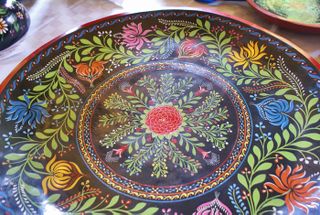
Hand-lacquered wooden bateas (shallow trays) are a specialty of the Pátzcuaro/Uruapan region. The maque (lacquer) technique is intricate and time-consuming; the tray is carved from pine, cured, and then decorated using centuries-old craftsmanship and dyemaking knowledge. This batea measures approximately 50cm in diameter (1.5 feet).
The artisans' competition, an important part of the annual Uruapan Tianguis Artesanal de Domingo de Ramos (Palm Sunday Artisans' Festival), occupies the Fábrica de San Pedro during the fair's opening days. Any of the artisans who exhibit at the fair can enter the competition; they show the best of their best work.
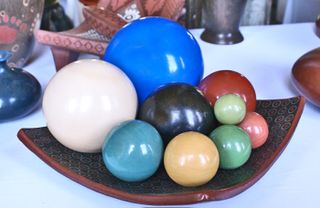
Clay spheres and their tray are made in Zinapécuaro, Michoacán.
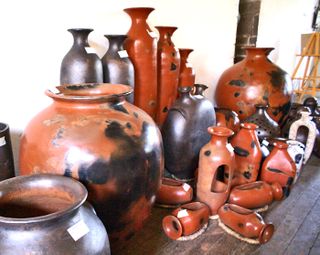
These cocuchas (clay pots from Cocucho, Michoacán) can be as tall as an adult person. Cocuchas are wall-built, not made on a wheel. The black spots on the clay are kiln burns characteristic of the work. Once the pots are fired, they are burnished with stones to create the shine.

A guaje (hard-shell squash), hollowed out, cured, and decorated with hand-prepared maque (lacquer). The artisan applies the base color lacquer and allows it to cure. After preparing vegetable dye lacquers, the artist incises a design into the dry base lacquer and removes the individual color sections, leaf by leaf and stem by stem, petal by petal. The artist inlays all of one lacquer color and allows it to cure. He or she then removes the design elements of the next color and repeats the inlay process. Finishing a guaje as detailed as this one requires many weeks of work.

Another batea, this one made of extremely heavy hand-hammered copper from Santa Clara del Cobre. The copper is hammered from an ingot and then engraved and finished. The value of a copper piece such as this depends on two variables: weight and artistry.
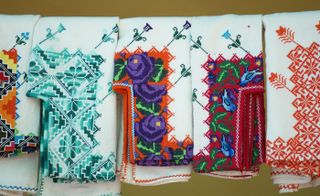
Guanengos (regional blouses) are hand-cross stitched in many Purhépecha towns in Michoacán.
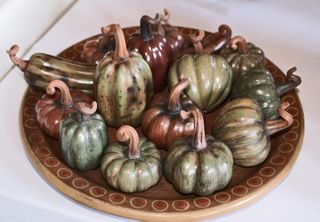
Mexico Cooks! tried to purchase this clay tray filled with 14 calabacitas de barro (little clay squashes). We were so disappointed to find that it had already been sold to the Michoacán State Museum. It would have looked quite charming on our dining room sideboard.
Try to come to the Tianguis Artesanal de Domingo de Ramos with us next year. There's nothing like it back home.
Looking for a tailored-to-your-interests specialized tour in Mexico? Click here: Tours.
Leave a Reply